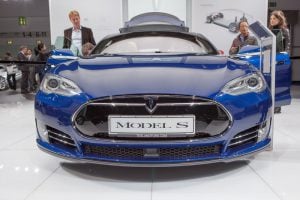
Tesla’s highly anticipated battery day is now in the books, and many investors have been selling the news today. At least one analyst slashed his price target for Tesla stock following the event, while at least one analyst upgraded it to Buy.
Q2 2020 hedge fund letters, conferences and more
New technology that was announced at Tesla’s battery day
During Tesla’s battery day event, it announced that it was in-sourcing 100 gigawatt-hours of cell capacity 2022 and 3 terawatt-hours by 2030. The automaker could have access to more cell supply from external suppliers as well. It currently has about 60 gigawatt-hours of outsourced cell supply right now.
Tesla also announced plans for a $25,000 vehicle in three years and wants to aim to produce 20 million vehicles, although it did not say by when. The company’s new battery technology is already in production at its pilot facility in Fremont, which aims to reach 10 gigawatt-hour capacity in one year. Within the next 12 to 18 months, the company expects to start seeing the benefits of its new battery technology. It expects to fully realize the advantages of the new technology in about three years.
Tesla also revealed a new larger cell form factor which features a tab-less design, 16% range increase, six times the power of the previous cells, and five times the energy capacity of previous cells. A new manufacturing process for the cells will drive a 75% decline in investment per gigawatt-hour of capacity, and a footprint per gigawatt-hour that’s 10 times smaller than the previous technology.
The company also said its new technology has silicon at just $1.20 per kilowatt hour, which is much lower than other silicon approaches and increases the range 20%. Tesla is also working on multiple cathode approaches with high nickel, cobalt-free chemistries. Batteries for lower-cost vehicles will have a lithium iron phosphate chemistry, while batteries for longer-range vehicles will have a nickel and manganese chemistry, and batteries for mass-sensitive vehicles like the semi and Cybertruck will have a high-nickel chemistry.
Tesla stock price target cut after battery day
In his report on Tesla’s battery day, Canaccord Genuity analyst Jed Dorsheimer said bulls will like the operational and systems approach to reducing manufacturing costs for auto and energy. However, he said bears will probably point out that the company is starting to look less like a tech company and more like a modern-day automaker.
He questioned why the company has revealed plans for a $25,000 vehicle when it hasn’t even successfully achieved the $35,000 vehicle milestone because most Model 3s that are sold cost more than that. He would rather see steady deliveries of the $35,000 Model 3 before the company turns its attention to a $25,000 model.
Dorsheimer also pointed out that Tesla is focusing on energy return on energy invested, which he agrees with. However, he sees significant execution risk. The automaker aims for a 56% reduction in dollar per kilowatt hour and a more than 50% in effective range.
He reiterated his Hold rating and cut his price target for Tesla stock from $442 to $377 following the battery day event. Meanwhile, Deutsche Bank analyst Emmanuel Rosner upgraded Tesla stock from Hold to Buy and raised his price target from $400 to $500.
Positives at Tesla’s battery day
Credit Suisse analyst Dan Levy maintained his Neutral rating and $400 price target following Tesla’s battery day. He outlined three positives and three areas of concern. First, he noted that the plan reinforces the automaker’s long-term growth narrative. He felt that for those thinking about Tesla as a growth stock, there was plenty to be excited about at the battery day.
Second, he said the announcements at Tesla’s battery day show how the company is opening up further growth potential by reducing cost. Specifically, the company focused on its plans for vertical integration by in-sourcing its battery manufacturing, which it expects to drive a 56% decrease in battery cost. Levy noted that it’s unclear where the company is today, but he estimates it’s currently at around $125 per kilowatt hour.
Third, he said the event was another reminder of how far Tesla is ahead of other automakers in the electric vehicle market. He said the company’s plan to commercialize next-generation batteries and focus on scaling manufacturing will determine its success. He noted that no other automaker has achieved the level of vertical integration Tesla is aiming for, including plans to integrate down to the raw materials.
Causes for concern
Levy was concerned about the challenges that will come with ramping manufacturing. He noted that the company’s capacity expansion plan is very ambitious and that the success of its battery strategy depends on its ability to ramp production. He added that Tesla has a “spotted” history on manufacturing as it abandoned plans for a highly automated general assembly line in Fremont.
Levy is also concerned because not everything Tesla is doing with batteries is unique. He noted that other cell makers have talked about increasing nickel concentration in the cathode and putting more silicon in the anode. They have also talked about using dry coating for the electrode. He said it is possible that Tesla is ahead of other cell makers in these areas, but it’s unclear.
Finally, he wanted to hear more about other aspects of Tesla’s battery strategy during the day. He noted that the automaker didn’t talk much about its plans to supply electric powertrains to other companies, although its targets imply the potential to do so. He also said there is more to learn on the growth path for Tesla Energy as the company didn’t discuss its plans to grow in stationary storage.
The post Analysts weigh in on Tesla’s battery day event: Causes for concern? appeared first on ValueWalk.
